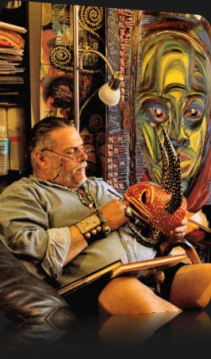 |
Jay Lonewolf An Extraordinary Painter |
“Darkness is my light and movement is my color”
Jay Lonewolf is an extraordinary painter. His deep passion to express the powerful 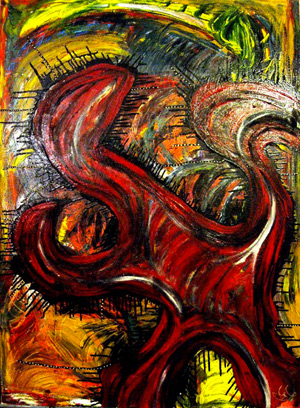 visions of his dreams could not be dampened by his visual problems or by those around him who thought he could not become an artist. It spurred him to develop unique approaches to painting. These techniques have bridged the gap of his vision problems from Achromatopsia while taking his paintings to levels few artists ever achieve.
visions of his dreams could not be dampened by his visual problems or by those around him who thought he could not become an artist. It spurred him to develop unique approaches to painting. These techniques have bridged the gap of his vision problems from Achromatopsia while taking his paintings to levels few artists ever achieve.
Though Lonewolf has had to deal with the issues of Achromatopsia throughout his life, he did not treat his visual issues as a handicap. Instead, he methodically worked to find a different method that would fit his talent.
“Society calls it an affliction. I call it seeing the world differently.”
- Jay Lonewolf
Lonewolf’s visual problem began a few months after birth and by age 7, he had been diagnosed with complete rod monochromacy. This is the most severe form of congenital Achromatopsia which resulted in total colorblindness. 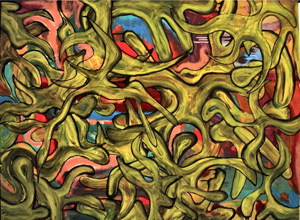 Since infancy, his world has been colorless and with reduced acuities or sharpness of vision. Most importantly, he has a severe aversion to bright lights since they can overwhelm his vision.
Since infancy, his world has been colorless and with reduced acuities or sharpness of vision. Most importantly, he has a severe aversion to bright lights since they can overwhelm his vision.
Achromatopsia left his eyes with only the rod photoreceptor cells that we use to see with at night. He lacked functioning cone cells that provide not only color vision, but vision in bright lighting. This left him in a world where he could function best only in very dim 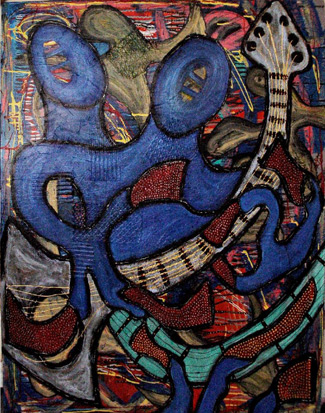 lighting. In low lighting, his vision could begin to come alive, whereas bright daylight requires him to squint and blink leaving him “mirages” of vision between the blinks.
lighting. In low lighting, his vision could begin to come alive, whereas bright daylight requires him to squint and blink leaving him “mirages” of vision between the blinks.
He soon learned to use dark filters to turn day to night. Lonewolf often used two sets of tinted glasses together to control the light. But even this was not enough to control the light for his paintings.
Discovering His Talent as a Child
At age 7, Lonewolf’s artistic ability was discovered by his grandfather. His grandfather took him to Prospect Park in Brooklyn and set him up with a canvas, paints, and a sketch pad. Soon his grandfather observed that he was painting with very good techniques, but in unusual colors. Shortly after that, his parents enrolled him in an art school for the gifted where within a week he was sent home with a note taped to his forehead, which read, “We cannot teach the ignorant.”
Enraged, Lonewolf’s mother went to the school the next day. The art teacher said that Jay was gifted artistically, but they couldn’t teach him because he wouldn’t use the assigned colors.
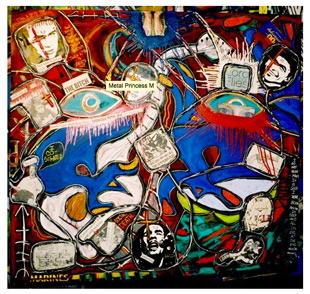 When his mother informed the teacher, “My son would love to be able to follow your instructions like all the other gifted children, however, my son has never seen the color of his own eyes. He is completely colorblind. His world is black and white.” Neither his mother nor teacher could contain their tears. Lonewolf never took another art class.
When his mother informed the teacher, “My son would love to be able to follow your instructions like all the other gifted children, however, my son has never seen the color of his own eyes. He is completely colorblind. His world is black and white.” Neither his mother nor teacher could contain their tears. Lonewolf never took another art class.
"When I was a child, no one wanted to teach me art because of my affliction, which was my passion, nonetheless I did not allow this to stop me. I taught myself art and now 47 years later, master painters from around the world call me in my studio to ask my opinion and about the theory I created which has made creating art without the benefit of seeing color possible.”
- Jay Lonewolf
He has never forgotten the taunting he received as a child. When kids around me found out, they were vicious, he says. I kept it all bottled up inside. Now I use that when I paint. Now I don’t get chastised, I get complimented.
His Artwork
His inability to see any color might come as a surprise to anyone who has seen his paintings, which burst out with vibrant hues. 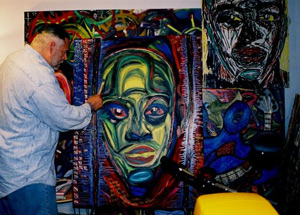 Lonewolf had to find ways to deal with the overwhelming light and glare he experienced even in normal room lighting. Lonewolf had been painting in the dark to avoid the overwhelming lights, He then learned that when the Spanish artist Goya was going blind, he began to paint by candlelight.
Lonewolf had to find ways to deal with the overwhelming light and glare he experienced even in normal room lighting. Lonewolf had been painting in the dark to avoid the overwhelming lights, He then learned that when the Spanish artist Goya was going blind, he began to paint by candlelight.
Lonewolf learned that in the dim light of candles his rod vision could come alive. “In the beginning, all I was doing was black and white,” Lonewolf says. “I felt that I needed to explore more.” Lonewolf needed a way to add color without being able to see any colors.
One day, Lonewolf tossed a stone into the water. He noticed the how the waves rippled through the water and realized he could capture this motion in his art. Lonewolf ingeniously began to create a system that integrated visual movement.
He uses the dim light of candles, mirrors to reflect the images, and fans to constantly shift the patterns of the candlelight that reflect off the mirrors onto his canvas.
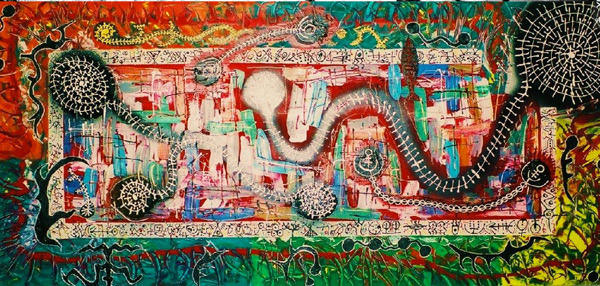
Lonewolf says. ‘It is like a river flowing with a dream dancing on the canvas.” He creatively uses the reflections and movement of the shadows from the candlelight to paint, while adding texture to his artwork with blobs of paint, melted wax and pieces of wire mesh.
Understanding His Vision in Creating His Artwork
Lonewolf’s response to the movement in creating his art may relate to the fact that as a complete achromat, he only has only rod cells functioning in the retina. Most of us have cone cells that dominate our visual experience proving color and sharp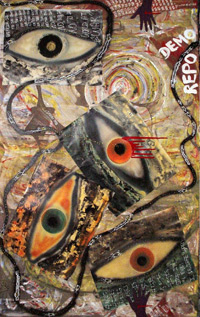 central visions. Two things which Lonewolf lacks.
central visions. Two things which Lonewolf lacks.
Rod cells, which only function in very low light, are wired in clusters that create great sensitivity to movement in our side vision. A thousand rod cells may be arranged to detect a specific motion and direction. This creates, in low light situations, great sensitivity to movement in our peripheral vision.
Thus, Lonewolf, though not a vision scientist, developed a unique system to paint that fully exploits the human rod cell vision system, which functions only in very dim lighting but is very responsive to moving images from the flickering candles. Thus, in not having the vision from his cones cells, it opened him to see the potential of exploiting his functioning rod vision in ways that others could not see. In a sense, other artists are blinded by their good vision. Today many artists come to try and learn from Lonewolf.
“What you call color, I call movement. Darkness is my light and movement is my color. ” - Jay Lonewolf
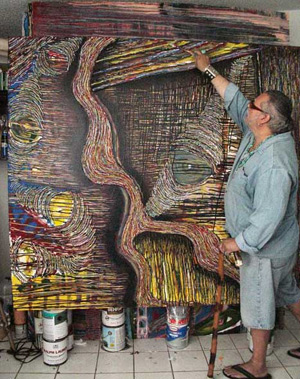 ”I want people to touch my paintings.” he said. “They’re touching a part of my soul.” I get kind of offended if you don’t want to touch it.” Lonewolf says. “Sometimes artists are too sensitive about their finished works. I think that after the creation process, sensitivity should take a nap.”
”I want people to touch my paintings.” he said. “They’re touching a part of my soul.” I get kind of offended if you don’t want to touch it.” Lonewolf says. “Sometimes artists are too sensitive about their finished works. I think that after the creation process, sensitivity should take a nap.”
“There are many ways to see the world when you see color. However, there are many more ways to feel it when you do not.” - Jay Lonewolf
The Painter Within
Lonewolf wants to be recognized simply as a painter. He rejects the label of the colorblind painter. He doesn’t follow any formal established art movements. He 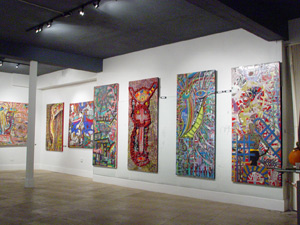 considers himself an abstract impressionist.
considers himself an abstract impressionist.
“Voodoo Survivor” is Lonewolf's most recent addition to his Wall Street Manifesto series. Combining brilliant fusions of graffiti, color, political commentary and urban symbolism, his series has stirred many fans. The Wall Street series are individual essays on today’s economic crisis. More offerings include his series “Mystic Mandolin” and “Pow-Wow with the Prophets” with “Lady Recession”. Surprisingly, Lonewolf created these two years before the Wall Street meltdown. As nearly always Lonewolfs ideas come from his dreams.
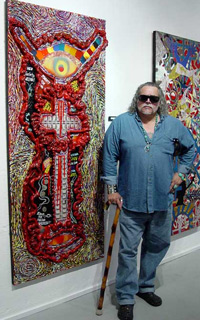 “My journey is a search of self through the many dreams one has throughout their life. As a creative being I must ask myself, is art an extension of my search for being or the creative nature found in my quest. When I paint I do so because there is something inside a very deep place attempting to speak and make its way to the surface in order to invoke something from humanity that would otherwise remain dormant. I suspect the philosophers, critics and the romanticist shall enjoy this strange libation of such an endeavor as I am sure they shall ultimately judge me.”
“My journey is a search of self through the many dreams one has throughout their life. As a creative being I must ask myself, is art an extension of my search for being or the creative nature found in my quest. When I paint I do so because there is something inside a very deep place attempting to speak and make its way to the surface in order to invoke something from humanity that would otherwise remain dormant. I suspect the philosophers, critics and the romanticist shall enjoy this strange libation of such an endeavor as I am sure they shall ultimately judge me.”
His Life Beyond Painting
Jay Lonewolf is known as an extraordinary painter, but he is also an Apache descendant with a strong spiritual connection to the burden of all native people. He 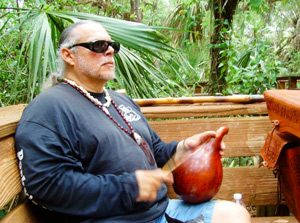 has given a helping hand to many people and others less fortunate over the years. Lonewolf donates some of his earnings to help the poor and homeless, and has stood outside churches and shelters giving out shirts, sweaters, socks and other essentials. ”We were so poor when I was growing up, I feel like I have to do something to give back.” he said.
has given a helping hand to many people and others less fortunate over the years. Lonewolf donates some of his earnings to help the poor and homeless, and has stood outside churches and shelters giving out shirts, sweaters, socks and other essentials. ”We were so poor when I was growing up, I feel like I have to do something to give back.” he said.
Lonewolf is also a percussionist with over four decades of experience. He often performs at his gallery shows.
His websites:
